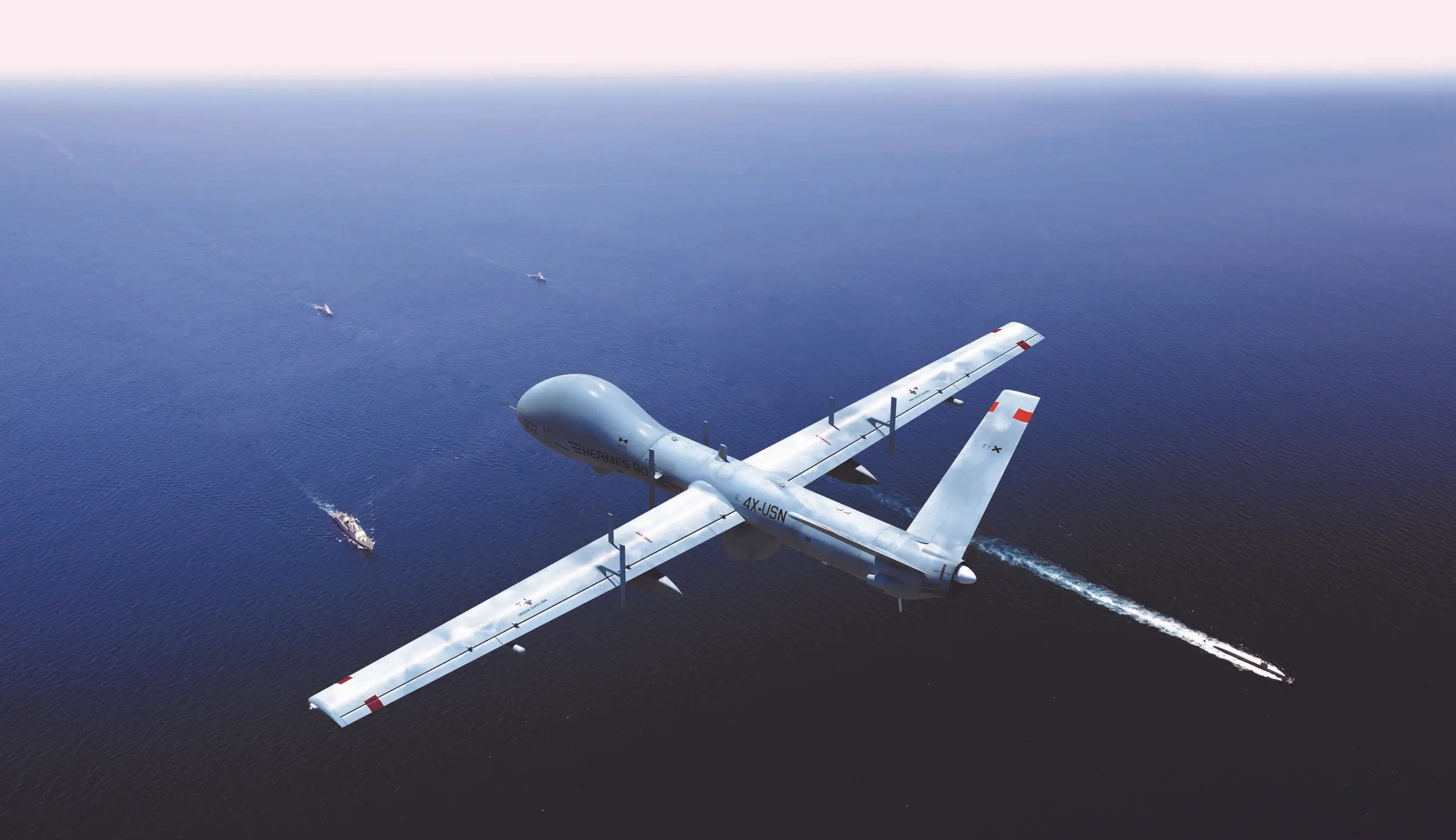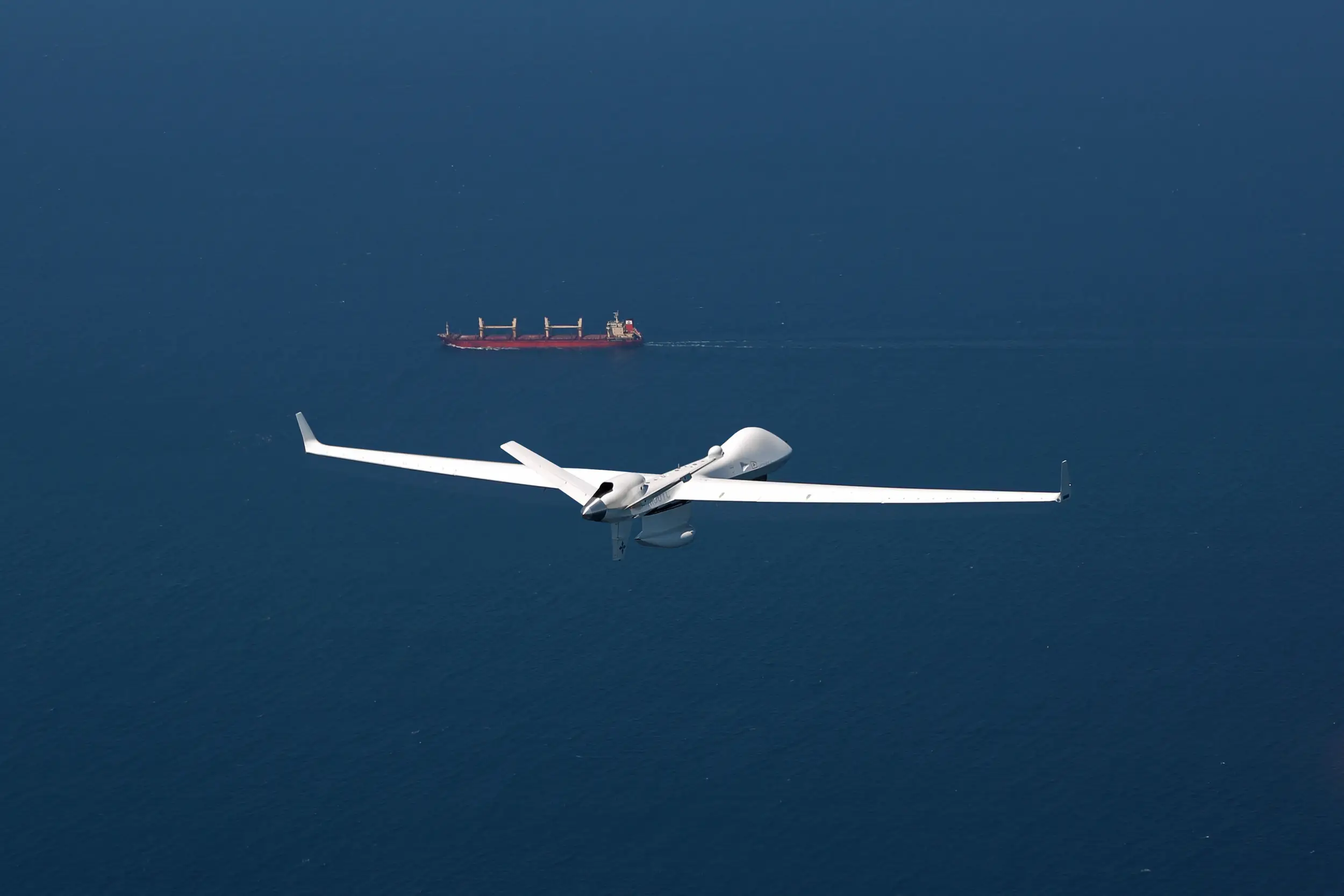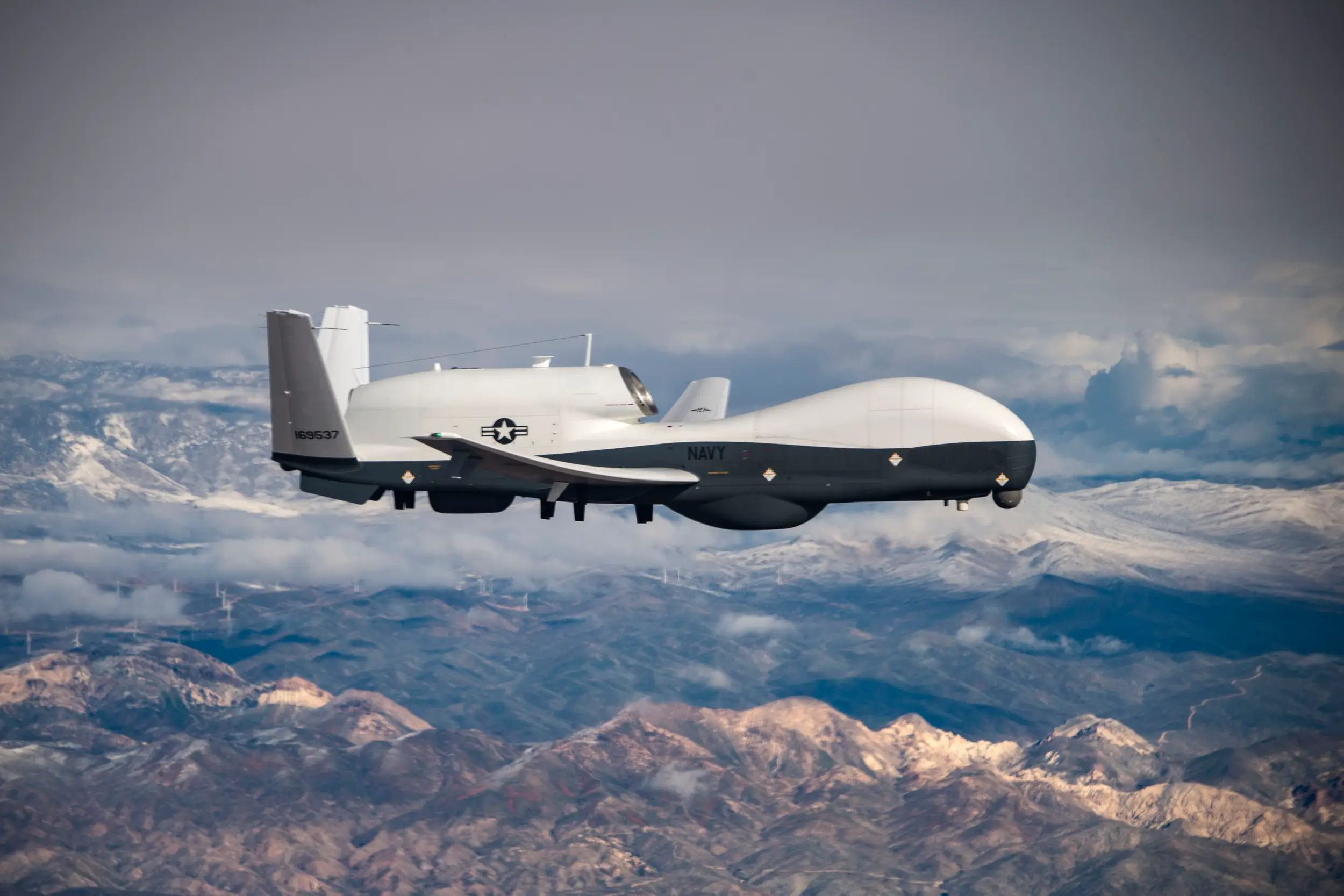
REPORT HOME > SEA VIEWS
june 2023 | technology report | UAS
With the persistence and endurance of high-end UAS now a proven benefit in the maritime surveillance role, developers are examining how new payloads and networking capabilities can take these assets to the next level.
Above: Elbit's Hermes 900 is increasingly used in maritime surveillance roles for naval customers and other government agencies. (Photo: Elbit Systems)
Medium-altitude long-endurance (MALE) and high-altitude long-endurance (HALE) uncrewed aerial systems (UAS) offer a number of key advantages for maritime surveillance. Developers remain focused on enhancing the platforms to improve resilience and endurance, along with pursuing new payload technologies.
The benefits of UAS in such roles are clear. The most obvious advantage is endurance, with MALE and HALE aircraft capable of operating for longer periods of time than crewed platforms, noted Brent Sadler, senior fellow, naval warfare and advanced technology, at the Center for National Defense in the Heritage Foundation, a US think-tank.
‘That’s the first advantage – the amount of time you can have sensors on a target at distance,’ he stressed.
The second advantage is related to risk, Sadler added, particularly in a wartime environment, or when countering piracy or similar activities. ‘You can send these into dangerous places, send them in pretty close, and you’re not putting a human operator or pilot at risk.’
Third, he pointed to the cost factor. Because the aircraft are smaller, they require less fuel, and there may be savings in terms of personnel, he added. While there will still need to be human operators and maintainers, they are often located in one place, reducing costs.
Additionally, Sadler said that systems today act as part of a wider network to support maritime surveillance, including uncrewed surface vessels, autonomous underwater vessels and more. This ‘networking’ aspect will be a key element looking forward, he noted.
Use cases
Elbit Systems produces the Hermes 900 StarLiner, a MALE UAV that is increasingly used in maritime surveillance roles for naval customers and other government agencies, said Amir Bettesh, VP of marketing and business development at the company’s UAS – Airborne Division. The UAV is certified to fly in civil airspace, so can travel over mainland and populated areas, he added.
Bettesh said that UAVs can support operators with performing ‘dull and boring missions – you need to scan a very big area of water and find abnormalities, such as ships that are not meant to be there or vessels that transmit AIS [Automatic Identification System] data that is not their own’.
He argued that UAVs like Hermes can hunt for these abnormalities using advantages unavailable to crewed platforms, such as the ability to fly for longer periods, up to one day. The aircraft can support maritime radar and electro-optical payloads, Bettesh added, so can scan thousands of square kilometres in a single hour.
This data is transmitted to a headquarters, such as a naval base, which ‘can change missions and targets during the flight, because everything is in real time’.
Bettesh pointed to various aspects of technical development in recent years, including a focus on making platforms like the Hermes 900 more robust and weatherproof, through anti-icing and lightning protection, as well as civil certification.
There has also been a strong focus on payloads. For example, he said ELINT packages are ‘very popular because you can find the radars on enemy vessels, you know their location, the radar they’re using, you can protect yourself and others’.
Additionally, he pointed to the ability to deploy sonobuoys from UAVs for anti-submarine warfare (ASW) missions. This is possible because the aircraft can now support more payload options, while the buoys themselves are smaller.
Adaptive approach
C Mark Brinkley is senior director of strategic communications and marketing at General Atomics Aeronautical Systems (GA-ASI). The company’s MQ-9A Reaper MALE UAS has been adapted for the maritime market in recent years, Brinkley said, notably through the MQ-9B SeaGuardian variant, which has a range of maritime intelligence, surveillance and reconnaissance (ISR) capabilities, ranging from ASW to search and rescue and over-the-horizon targeting.
Above: The MQ-9B SeaGuardian has taken part in several recent exercises and experiments to further develop the maritime domain awareness capabilities of the platform. (Photo: GA-ASI)
Brinkley said the company wants to see an enhanced focus on airborne ISR in the maritime domain, with the goal of providing ‘information dominance across thousands of miles of open ocean while reducing the risk, stress and operational costs associated with using manned maritime patrol aircraft [MPAs]’.
He said the MQ-9B can provide about 80% of the capability of a large MPA at about 20% of the cost per flight hour.
Brinkley pointed to a number of developments to the system, with the SeaGuardian focused on integrating emerging technologies for use across maritime operational areas.
For example, he said GA-ASI has experimented with integrating low-Earth-orbit SATCOM for the first time, to prove the ability to deliver pole-to-pole coverage at latitudes previously unavailable to UAS.
‘The opportunities this provides in the harsh climate of the Arctic region alone opens up myriad possibilities for the future of MALE UAS operations,’ Brinkley said.
He highlighted recent exercises and experiments that have aimed to further develop the maritime domain awareness capabilities of the MQ-9. For example, Brinkley said the system featured in the USN’s Group Sail exercise in April 2023 in Hawaii, where it conducted ISR, long-range fires and simulated battle damage assessment, integrating with navy ships and aircraft.
Looking to the future, Brinkley said GA-ASI is investing heavily in advancing autonomy, artificial intelligence (AI) and machine learning (ML) for UAS operations through an ongoing series of autonomous flights.
‘It’s not just about AI/ML – it’s about what that enables us to do in terms of our networking structures and the new concepts of operation it makes possible and so on,’ including in maritime domain awareness and related tasks, he said.
‘We have been teaching our AI pilots to make critical decisions, and in some cases even rewrite their own code in-mission to implement lessons learned immediately and better react to the challenges faced,’ Brinkley added, noting that much of this has been achieved using the company’s MQ-20 Avenger unmanned combat air vehicle.
‘As global militaries explore concepts that would allow affordable, jet-powered UCAVs to operate alongside and in partnership with manned aircraft, we are working to define the underlying technology that will make those aircraft effective and safe.’
Global awareness
Northrop Grumman meanwhile is developing the MQ-4C Triton for the USN, based on the company’s Global Hawk. Rho Cauley Bruner, director of the Triton programme, said that persistent global maritime awareness is central to deterring adversaries, or competing and winning against them.
‘There is no time like now for reliable real-time information and behaviour analysis regarding naval activities to ensure leaders make informed decisions and avoid miscalculations,’ she noted.
Cauley Bruner said the Triton is designed to provide continuous communications relay at an altitude of more than 50,000ft and endurance beyond 24h. It uses long-range sensors to detect, classify and track maritime targets outside the ‘detection-shoot range of enemy ships and surface-to-air missiles’.
Above: Northrop Grumman is developing the MQ-4C Triton for the US Navy, where it will be used in a surveillance role. (Photo: Northrop Grumman)
Triton is on track to achieve initial operating capability in the autumn, she added, with the partners working on developing its multi-intelligence configuration. The aim is to ‘execute our strategy for advanced capabilities insertion and mission expansion to keep pace with the threat, and ensure Triton leads in a seamlessly connected fleet for information dominance, a critical step as the branch achieves its naval operational architecture to enable distributed maritime operations’.
The company is using its Triton testbed – a crewed Gulfstream IV surrogate – to research, develop, integrate and demonstrate technologies to meet current and future ISR and targeting requirements, Cauley Bruner noted.
‘In late 2021, Northrop Grumman demonstrated onboard edge processing using real-time [AI/ML] techniques to identify potential threat vessels in an otherwise crowded maritime environment,’ she said.
‘We also recently demonstrated JADC2 across distributed platforms, showcasing interoperability among F-35, MQ-4C Triton, E-2D Advanced Hawkeye, and surface vessels.’
As with the SeaGuardian, there has been a range of activities and exercises aimed at preparing the UAV for integration with the navy, Cauley Bruner said. For example, the system’s use as a ‘gateway node’ was demonstrated in a flight test on the surrogate aircraft, focusing on its ability to connect fifth-generation platforms with naval assets across a distributed maritime fleet.
Cauley Bruner emphasised the utility of UAS in surveillance and maritime domain awareness into the future.
‘Satellites are limited and predictable, offering intermittent coverage. Manned reconnaissance aircraft only provide a limited ISR at the sacrifice of their other missions, such as [ASW] patrols,’ she said.
‘Episodic coverage from satellites can miss – or misinterpret – actions. Persistent surveillance allows the prediction of an adversary’s behaviour and enables better planning, greatly enhancing joint military responses and operations.’


